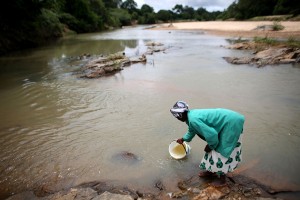 At that time with population growth doubling every 20 years and urban populations growing at 6 per cent per annum with the drift from rural areas to the urban centers, this meant that we had to build a major new dam for raw water supply every 5 to 10 years. Urban Councils were left to build their own dams with State assistance and water sales constituted a significant proportion of income to Councils on top of electricity sales, license fees including vehicle licenses, rates and taxes.
At that time with population growth doubling every 20 years and urban populations growing at 6 per cent per annum with the drift from rural areas to the urban centers, this meant that we had to build a major new dam for raw water supply every 5 to 10 years. Urban Councils were left to build their own dams with State assistance and water sales constituted a significant proportion of income to Councils on top of electricity sales, license fees including vehicle licenses, rates and taxes.
Since Independence the Central Government has steadily stripped Councils of revenue sources starting with electricity sales and the transfer, without compensation of the two thermal power stations in Harare and Bulawayo to ZESA, the loss of control of bulk water supplies to ZINWA who now charge for bulk water supplies even from dams built by the Councils and the loss of vehicle license fees. In addition no new dams have been build now for over 25 years despite rapid urban expansion – so that today the infrastructure supplying Harare metropolitan area with over 6 million inhabitants, has a water infrastructure for a City of half a million people.
Bulk storage of water in all urban areas is down to 18 months or less rather than the 3 years previously stipulated and plans for new bulk water sources such as the Gwaai/Shangani and Harare North water supplies, have not made any progress despite years of planning and promises. Bulk water supplies remain the monopoly of ZINWA which has failed dismally and cannot even manage the aquifer system to the north of Bulawayo which has the potential to supply the full requirements of the City.
In addition to this, the decision, for purely short term political reasons to cancel, at the stroke of a pen, over US$600 million in outstanding rates and taxes in 2013 by the then Minister Chombo has crippled the Urban Councils financially. With total revenues from all sources for all urban Councils now running at about US$600 million a year, half of which is in Harare and urban council populations now exceeding 8 millions, gives the Councils a annual spend of just US$75 per capita per annum.
This is a totally inadequate sum to deal with the many urgent priorities. Councils receive no transfers from Central Government for their extensive Health and Education services, total transfers from ZINARA for road maintenance does not come anywhere near enough for road maintenance of the twenty thousand kilometers of urban roads. In the case of the City of Harare vehicle license fees used to be nearly US$10 million a year – ZINARA has sent less than US$1,2 million to the City this past year.
The new national Constitution provides for Central Government to distribute 5 per cent of Central Government revenues to local authorities – that is a sum of US$200 million a year. For three years now the Zanu PF led Government, with the full support and collusion of the Ministry of Local Government, has failed to pay this sum – largely because the Councils are controlled by the MDC T.
Instead of supporting the democratically elected Councils, the Minister and the Ministry of Local Government spend 90 per cent of their time trying to undermine the Councils and to prevent them achieving the goals set for them by their electorates. Councils are hounded, subjected to arbitrary suspensions and their decisions rescinded at will. With totally inadequate resources and little support from Central Government it is no surprise that the Urban Councils are failing in their efforts to maintain water supplies and other services to the rapidly growing populations for which they are responsible.
In 1980, the national population was about 9 million and was growing at 3,6 per cent per annum with a life expectancy of 60 years. Today, 37 years later our population is just 13 million and the average life expectancy is 35 years. If there are nearly 5 million Zimbabweans living outside the country in the Diaspora, this means that there are some 5 million people who should be alive and living in Zimbabwe but who have died prematurely over the past 37 years. Zimbabwe has the highest maternal mortality and infant mortality in the World. Our death rates have doubled since 1980 involving about 200 000 people a year.
For the Minister to blame MDC led Councils for the death of just 500 people this year is simply laughable. Zanu PF and the Minister himself are guilty of deaths on a scale that could easily be described as genocide. What else do we call the tens of thousands of women who die each years in childbirth or the tens of thousands of children who die before the age of five or the 30 000 people who die from Malaria or the 60 000 people a year who die of Tuberculosis.
The water crisis in our urban centers is in many ways a National Emergency and should be treated as such by everyone concerned.
Eddie Cross
MDC – Shadow Minister of Local Government
Post published in: Featured


